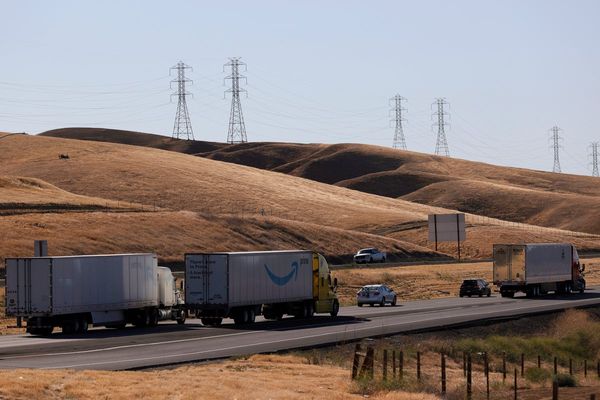
On 13 August last year, a villager in Ostrówka, in the east of central Poland, posted two pictures on Facebook featuring groups of men, women and children walking through the cornfields with bags on their backs.
They were families from Syria, Afghanistan and Iraqi Kurdistan, and they were among the first asylum seekers to enter the country from Belarus. The post was accompanied by the following short text: “In the heat of day through wheat, at night through corn, they sneak through, they wander, just to get to the west. Great politics and slight refugees leave their print on the fields near Ostrówka.”
Few could have imagined that those people were the prelude to a border crisis that would result in dozens of deaths.

The makeshift shelter of a Syrian family with small children in the forest near Narewka, Poland
The Belarusian president, Alexander Lukashenko, had just started to organise the movement of asylum seekers with the promise of a safe passage to Europe, apparently in reprisal for sanctions that Brussels had imposed on his regime. A new migration route to the EU had opened.
The humanitarian emergency reached its peak in November, when the Belarusian security forces escorted thousands of asylum seekers to the Polish border in an escalation of the crisis. Witnesses told the Guardian how Belarusian troops gathered groups of up to 50 people and cut the barbed wire to allow them to cross. Most of the asylum seekers were caught, and illegally and violently pushed back to Belarus by Poland’s border guards.
But hundreds managed to escape into the forests. Trapped between the violence of the Polish authorities and false promises from the Belarusians, families lived in small tents, trying to keep warm in damp sleeping bags as night-time temperatures fell below zero.


Polish border guards at a checkpoint near the border with Belarus and with a family who were hiding in the forest
In response to the Belarusian threats, Poland’s hard-right government quadrupled the presence of border guards and troops in the area and created a two-mile-deep militarised zone ringed with razor-wire.
It was a show of force not seen in the country since the end of the cold war. Dozens of checkpoints punctuate the perimeter of this so-called red zone, which is inaccessible to aid workers and journalists. The soldiers stop and search every car as police vehicles and helicopters monitor the area.



Top, a family from Duhok, Iraq, in Narewka, Poland, after crossing from Belarus. Above left, an Iraqi woman and her baby are taken to safety by aid workers before certain capture by Polish border guards
Every night in the forests, there is a race between border guards and aid workers to reach the asylum seekers hidden among the trees. If the Polish police arrive before the volunteers and doctors, they will probably send the migrants back to Belarus, with the risk that their health may deteriorate.
Many of those found in the woods can barely walk after travelling long distances on foot. Some have not eaten in days. The children often have signs of hypothermia.

The graves of asylum seekers in the Polish village of Bohoniki. Most of the people known to have died since the start of the border standoff were killed by the cold
At least 19 people have died since the beginning of the border standoff between Poland and Belarus. Most of them froze to death. Some were buried in the village of Bohoniki, near the Polish town of Sokółka, in the heart of the forest that claimed their lives. People told the Guardian they found the bodies of refugees torn apart by animals.
A family of asylum seekers said they had to bury their mother, covering her with leaves. “In the area of forest where migrants normally camp, you can smell an intense stench of decay,” says one resident.
Some Polish families have been hiding desperate asylum seekers in their homes. In the attics of the cottages scattered in the forests along the border, Iraqi Kurds and Syrians tremble with cold and fear, while border guards search for them outside. If found, the Polish families who have offered them shelter risk being charged with aiding illegal immigration.



Kamil Syller, a lawyer, top, and his wife, Maria Przyszychowska, with their daughter, above left. The green light in their home in Hajnówka, near the border, right, is a welcome sign for refugees
Kamil Syller and his wife, Maria Przyszychowska, started a network of residents and activists who put green lights in their windows to show that their home is a temporary safe space for refugees.
“We are trying to protect asylum seekers and now our activity has become a form of resistance,” says Kamil. “But we don’t want to be heroes and it’s becoming really frustrating.”
The green lights have also come to the attention of the Polish authorities. For weeks, Maria and Kamil’s home has been under surveillance. Border guards patrol the streets around their home and lie in wait for people to come out of the forest so they can capture them and push them back into Belarus.


A young Iraqi Kurd hides in a small attic. Border guards entered Syller’s house to take away two Syrians. The Polish lawyer filed papers with the European court of human rights in an effort to stop them being deported to Belarus
According to data from Grupa Granica, a Polish network of human rights organisations, about 10,000 asylum seekers reached Germany from Belarus via Poland by December. Many others were transferred to migrant camps near the Belarus border.
The Guardian spoke to dozens of asylum applicants in the Polish city of Białystok. All said they had arrived in Minsk by buying packages from travel agencies, which, according to the refugees, appeared to be closely connected to the Belarusian authorities. Despite promises from Turkish and Belarusian airlines to limit these flights, the crisis appears to be far from over. Thousands of asylum seekers remain in Belarus.

Inside a customs warehouse in Bruzgi, Belarus, which now houses about 1,000 asylum seekers


Asylum seekers washing outside in Bruzgi, where temperatures can fall to -12C, left. Alima Skandar, 40, right, from Iraqi Kurdistan, who was separated from her three children in November as they tried to cross the Polish border
As temperatures plummeted at the end of November, the Belarusian authorities began to move the asylum seekers to a customs warehouse in the village of Bruzgi, which has been turned into a dormitory for refugees. In this 10,000 sq metre space, patrolled by dozens of armed soldiers, about 1,000 asylum seekers are sleeping in makeshift cots made from planks and cardboard on shelving units once used for merchandise.
There are dozens of children and elderly people, many in need of medical help. Outside, people sit around and heat up food on a wood-burning stove. There are showers but no hot water. Winter temperatures in Bruzgi can fall to -12C.

Scraps of clothing hang from barbed wire at the checkpoint in Kuźnica as a reminder of those who tried to cross
Asylum seekers stranded in Bruzgi are clinging to the hope that Europe will rescue them, sooner or later. But their hopes were dealt a blow when Poland announced it had started building a €353m (£293m) wall along its frontier with Belarus aimed at preventing refugees from entering the country.
Little remains of the migrants who camped at the border for months – just a pile of rags and bottles. Scraps of clothing hang from the barbed wire, a bleak reminder of those who tried to make it to the other side.







